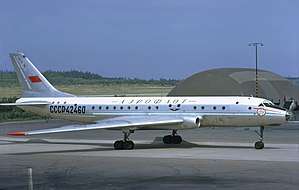Aeroflot Flight 2415
 An Aeroflot Tupolev Tu-104, similar to the one involved in the accident | |
| Accident | |
|---|---|
| Date | 28 November 1976 |
| Summary | Crew disorientation as a result of artificial horizon failure |
| Site |
near Klushino, Moscow region 56°01′11″N 37°17′30″E / 56.01972°N 37.29167°ECoordinates: 56°01′11″N 37°17′30″E / 56.01972°N 37.29167°E |
| Aircraft | |
| Aircraft type | Tupolev Tu-104B |
| Operator | Aeroflot |
| Registration | CCCP-42471 |
| Flight origin | Sheremetyevo International Airport, Moscow, Russia |
| Destination | Pulkovo Airport, Saint Petersburg, Russia |
| Passengers | 67 |
| Crew | 6 |
| Fatalities | 73 (all) |
| Survivors | 0 |
Aeroflot Flight 2415 (Russian: Рейс 2415 Аэрофлота Reys 2415 Aeroflota) was a regularly scheduled passenger flight from Moscow to Leningrad that crashed shortly after takeoff. The cause of the accident was attributed to crew disorientation as a result of artificial horizon failure in low visibility conditions.[1]
Aircraft
The aircraft involved in the accident was a Tupolev Tu-104B registered CCCP-42471 to Aeroflot-Russian Airlines. The aircraft rolled off the final assembly line of the Kazan Aircraft Production facility on 22 February 1960 and was delivered to the Ministry of Civil Aviation on 24 March 1960. In the aircraft's sixteen years of operation it accumulated 22,199 flight hours and 13,336 pressurization cycles.[2]
Crew
On board the plane were six crew members, of which four were cockpit crew and two were cabin crew.[2]
The cockpit crew consisted of:
- Captain Boris Nikolaevich Gorokhovsky, (Russian: Гороховский Борис Николаевич) serving as the pilot in command
- Co-pilot Igor Borisovich Nikolaev, (Russian: Николаев Игорь Борисович)
- Navigator Vladimir Viktorovich Gusev (Russian: Гусев Владимир Викторович)
- Flight engineer Vladimir Grigorevich Vasiliev (Russian: Васильев Владимир Григорьевич)
Sequence of events
| Final tally of passenger nationalities[3] | |||
|---|---|---|---|
| Nationality | Passengers | Crew | Total |
| 65 | 6 | 71 | |
| 1 | 0 | 1 | |
| 1 | 0 | 1 | |
| Total | 67 | 6 | 73 |
Flight 2415 took off from Moscow-Sheremetyevo International Airport despite bad weather at 6:53 local time. On board the plane were the six crew members as well as 67 passengers, including four children. The weather forecast for the evening was cloudiness limiting visibility to 1500 meters at best with mild winds. The plane took off from the runway at a safe speed of 290 km/h. After takeoff the pilots reduced engine power and radioed the control tower for instructions to proceed. The crew was instructed to head on a bearing of 265°; the pilots performed the maneuver by setting the ailerons for banking to the right. After banking 265° the aircraft continued to bank to the right, losing altitude and picking up speed in the process, putting the aircraft into a steep dive. The plane crashed into the ground 9.5 kilometers from the airport, exploding on impact and killing all passengers and crew aboard the plane.[4][3]
Causes
The State Supervisory Commission for Flight Safety board cited among the causes of the crash included failure of the artificial horizon, poor visibility from the cockpit, and lack of warnings indicating the failure of the artificial horizon. Due to the damage to the aircraft caused by the crash, it was impossible to determine if the ailerons were functioning correctly at the time. The cockpit voice recorder and flight data recorders were both missing the last six seconds of data, presumably as result of the damage in the post-crash fire. The board concluded that the crew demonstrated excellent calm in the emergency in their efforts to fly with incorrect data from the aircraft; weather was not determined to be a primary cause of the crash. It is worth noting that one member of the board, Markov, disagreed with the findings of the report and attributed the accident to pilot error; but he was overruled by Gosavianadzor who sided with the rest of the board.[3]
See also
- Aeroflot Flight 964, also a Tupolev Tu-104, crashed on approach experiencing similar artificial horizon failure.
- Aeroflot Flight 3932, another Tupolev Tu-104, crashed shortly after takeoff experiencing similar artificial horizon failure.
- Aeroflot Flight 1912, another Tupolev Tu-104 accident caused by similar instrument failure.
References
- ↑ "ASN Aircraft accident Tupolev 104B CCCP-42471 Moskva-Sheremetyevo". aviation-safety.net. Retrieved 2017-03-17.
- 1 2 "Туполев Ту-104Б Бортовой №: СССР-42471". russianplanes.net. Retrieved 2017-03-17.
- 1 2 3 "Катастрофа Ту-104Б Ленинградского ОАО в районе а/п Шереметьево". www.airdisaster.ru. Retrieved 2017-03-17.
- ↑ "Расшифровка переговоров. Катастрофа Ту-104Б Ленинградского ОАО в районе а/п Шереметьево (борт СССР-42471), 28 ноября 1976 года. // AirDisaster.ru - авиационные происшествия, инциденты и авиакатастрофы в СССР и России - факты, история, статистика". www.airdisaster.ru. Retrieved 2017-03-17.